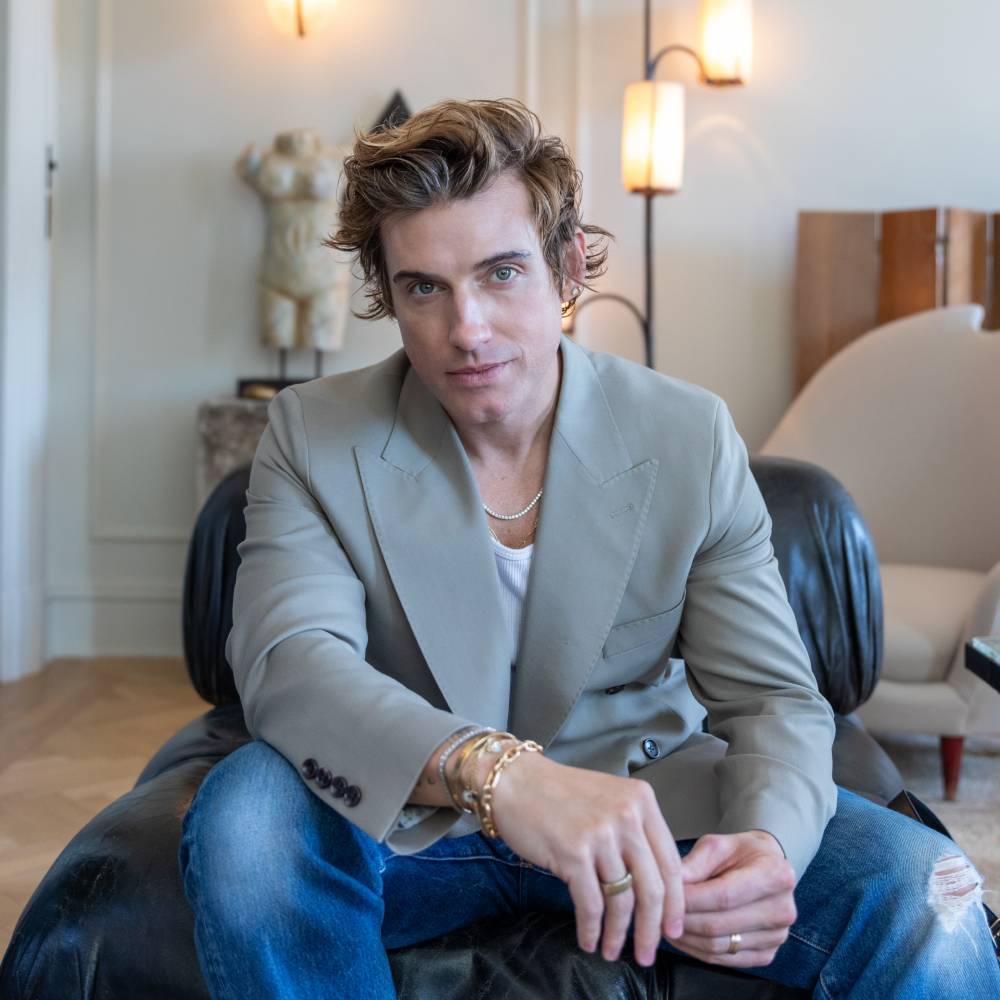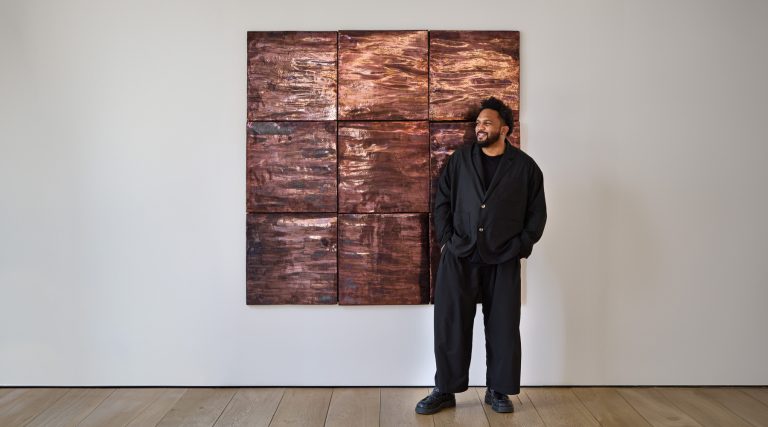
November 2010In addition to being an accomplished architect, Peter Marino is a passionate collector of intimately scaled bronzes sculptures. Photo by Douglas Friedman, top photo by Manolo Yllera
The word “baroque” comes from the Italian word for one of those gorgeous misshaped pearls that refuses nature’s perfect symmetry and instead goes a bit wild, building a calcareous shiny surface that’s dramatic and over-encrusted. Baroque art is built on similarly luscious opulence mixed with the Renaissance’s idealized figures — think classical art on holiday in sun-drenched Malta where no one is watching.
And art lovers are certainly basking in “Beauty and Power: Renaissance and Baroque Bronzes from the Peter Marino Collection,” which is visiting the Huntington Art Collections, in San Marino, California, through January 24, 2010, after opening at the Wallace Collection, in London. The show comprises 28 museum-quality examples of Baroque bronzes, all executed in an intimate maison elite scale of about six inches to two feet and created between 1550 and 1750. The work is culled from the personal holdings of New York architect Peter Marino, who got his start as Andy Warhol‘s designer but may be best known today as the visionary behind international flagship stores for Dior, Chanel, Louis Vuitton and the like. To get a sense of why Marino would be drawn to objects such as these, one could look at his Meadows Collection Retail Centre, a luxury shopping mall in Calgary, Canada, that fuses high-modern lines and Rococo whimsy with pretty audacious design wisdom that’s hard even for purists to assail.

The Huntington Art Collections, opened in 1928, are located within the former residence of 19th-century railway magnate Henry E. Huntington and his art-loving wife, Arabella. Photo by Tim Street-Porter

Laocoön, 17th century, likely cast in Italy. Bronze images courtesy of the Peter Marino Collection
Several points of note collide seductively here: the leather-clad, tattooed Marino; the barely checked erotic kinkiness of many of the bronzes he’s gathered; the prim Henry Huntington, who founded the institution that’s now agreed to put them on public view. Add to that the odder-still roots of baroque art: Protesting papal excess, selling of pardons, pagan images, Martin Luther said quiet humility got God’s attention. Rather than tone down the luxury, the astute ad men of the Counter Reformation pushed the elegance of Rome over the top. In the baroque, every straight line is a tendril, every surface is gilded, the emotional temperature high enough to capture the faithful with art felt as much in the body as in the soul.
According to Catherine Hess, chief curator of European art at the Huntington Art Collections and the organizer of the exhibition’s California iteration, whatever passions attracted Marino to this work, business tycoon Henry Huntington felt a similar draw some 100 years earlier. Here, Hess speaks with 1stdibs’ Marlena Donohue.

Bacchus and Ariadne, ca. 1793, by Corneille van Clève (1646-1732), cast in France
These are so precious and petite. Most often we associate the Baroque with huge, interdisciplinary art projects that included sculptures, wall treatments and paintings conceived together like stage design. We see this in the Throne of St. Peter by Bernini in the Vatican, for example, right?
True, but intimately scaled bronze statuettes actually developed as a serious art form in Renaissance Italy with a revival of ancient Roman bronze techniques. Statuettes would be displayed on a table or mantle and might duplicate well-known classical themes or existing sculptural groupings — like the Laocoön in Marino’s collection — and they became quite popular with wealthy and sophisticated patrons in the 16th and 17th centuries.
It doesn’t look as if we know who did Marino’s Laocoön, though it duplicates the famous marble telling of the story of the Trojan seer who tried to warn Troy not to take the horse and got punished by the Gods who had serpents kill his sons while he watched. It is just stunning, full of big heroic gestures and tons of pathos.
That one is not attributed, but Mr. Marino has premium examples of well-known artists of this genre, like Giovanni Battista Foggini, who did his David and Goliath. Here, classical narratives predominate, and biblical narratives, like Samson and the Philistine, tend to be rather eccentric episodes or chosen not so much for any obvious religious imagery but more for the active animation of the storytelling, the energy of the scene.

Samson and the Philistine, 1550-60, perhaps by Baccio Bandinelli, cast in Italy
Were these small objects considered minor arts, a bit like spin-offs for lack of a better term?
No, not at all. The artists doing these became very well known for just these sorts of objects and for executing a type of art-collectible that was considered very intricate and precise, as well as specific to this medium of bronze-casting.
The show was conceived in London, but each venue is adding something, is that correct?
Jeffrey Warren of the Wallace Collection conceived of the show and did a tremendous amount of research to produce the catalog, which is really a piece of remarkable scholarship on these bronze. He included certain objects from the London collection that he felt added context, and I added four objects that I felt made especially good points of comparison.
Can you elaborate?
The Huntington added several related examples from our own artistically important group of Renaissance bronzes, purchased by Henry Huntington around 1917. Huntington came to collecting these types of works rather reluctantly; he actually favored academic painting and images of children. Under the guidance of Joseph Duveen, the same dealer who was educating and selling to Henry Clay Frick and other important wealthy collectors at the time, Huntington slowly acquired key bronzes. We hoped it would be interesting to bookend two very different types of men separated by a century who gathered like objects.
There has been some commentary about the special-interest aspects of a major museum featuring objects owned and essentially preselected by high-profile collectors.
As I’ve said, for me, there has to be a serious or compelling reason to show a group of objects beyond who collected them, and I feel that was the case here.
What was the compelling reason?
I had just come to the Huntington from the Getty, where my specialty was, in fact, sculpture, and so when they passed the idea by me, I was thrilled; it made perfect sense to me. We thought it would be very instructive to include our pieces with Marino’s excellent examples as a way to have scholars and viewers learn about the subtle distinctions we can make about quality and technique, observations that permit us to check or refine an attribution to a creator, to speculate or conclude with greater certainly and to make close object-to-object assessments about whether a work is by this hand or that one.

Marino is seen here with his collection, though his image is not included in the show, lest it influence the viewer’s perception of the work. Photo by Manolo Yllera
Do you think that collections are windows into the collector? Does this show tell us something about Peter Marino?
The most I can say is, if you look at these objects, they are not staid portraits or equestrian statues. They are primarily chosen for their intense emotion, extreme visual beauty and eccentricity.
Well, eccentricity is in excess for sure: The show-stopper by Foggini depicting an almost ecstatic, winsome Apollo flaying the skin off the elbow of the husky satyr Marsyas certainly fits that bill. Given that the show features pieces from a high-profile collector who seems most comfortable cultivating a leather-and-chain persona, his image is conspicuously absent here. Any reason for that?
We did not include visuals of the collector, though it would be great to have the public know that art collectors do not have to be librarian types. Because he is such a large figure, we thought his presence might distract viewers from the work; I wanted the show to be about the work, and I think Mr. Marino might agree.


